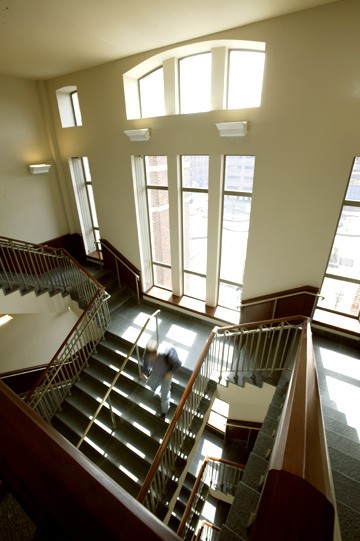In many new buildings, the design team attempts to maintain high visible light transmittance (VLT or VT) to "connect" occupants to the outside, provide views, and exploit natural daylighting. It is not only the amount of natural light that is important to building occupants, but also its quality, spectral composition, contrast, variability and directionality.
Wausau has developed the following checklist, for designers looking to enhance their use of natural daylight:
-Don't over-complicate daylighting. Use intuition and common sense in conjunction with available analysis tools. Daylighting design must include thermal analysis. Always think about solar heat gain control and daylighting together.
-Don't spend a lot of money on natural daylighting features if artificial lighting remains uncontrolled. Photo-sensitive controllers should be used to dim or extinguish indoor lights when unnecessary. Artificial lighting accounts for 40% of the energy used in a typical commercial building, and generates at least three Watts of heat for each Watt of visible light.
-Position lighting for effectiveness. Daylight-corrected fluorescent lamps integrate more seamlessly with natural daylighting strategies, and luminaires should be zoned, and placed, in a direction parallel to windows.
 -Use tall windows to maximize light penetration. Clerestory windows can be used to increase the effective height of transom lites without increasing window-to-wall ratio (WWR). Even relatively low WWR provides more than ample natural daylighting, if properly oriented and directed. -Use tall windows to maximize light penetration. Clerestory windows can be used to increase the effective height of transom lites without increasing window-to-wall ratio (WWR). Even relatively low WWR provides more than ample natural daylighting, if properly oriented and directed.
-Consider the concept of "effective aperture" (EA, the product of VT and WWR); it can be useful in assessing the relationship between visible light and window size. Start with an EA of about 0.30 on the north and south elevation, minimizing glazing on the east and west elevations whenever possible.
-Eliminate vision glass below sill height to reduce solar gain that carries no useful daylight, unless "downward" view is important. In general, window area should be no different in a daylit building than in a conventionally-lit building.
-Optimize glass selection by elevation using clear substrates and coatings on north-facing facades and "darker" glass on south, east and especially west facades. Use darker glass in large, view windows; use clearer glass in transom lites.
-Examine the proposed building program closely as it relates to natural daylighting. Make the need for daylight access a factor in laying out floor plans and assigning perimeter space. Use building geometry to control glare and solar access.
-Scale accordingly. While tall conventional windows may work well in providing natural daylight to "shallow" perimeter offices, more complex strategies are necessary to achieve daylighting in "deep" south-facing spaces.
-Add uniformity to daylight in open plan perimeter spaces with horizontal window spans. Even light distribution is more difficult with punched opening windows in private office or small classroom perimeter spaces.
-Calculate for daylighting depth. A conventional window can daylight an interior space to a depth approximately 1.5 times the window head height. Daylighting systems are necessary to increase penetration to 2.0 times head height, and are used to improve light distribution as well.
-Account for climate and geography. Interior light shelves, like the Wausau Clear StoryTM light shelves shown, are most effective for relatively clear climates at mid-latitudes for south orientations.
-Address glare and light shelf design separately. Most light re-directing devices like light shelves or profiled louvers are most effective only under "direct beam" clear sky conditions.
-Size and finish appropriately. For south-facing rooms, the depth of an internal light shelf should be roughly equal to the height of the clerestory or transom window above the shelf. Standard white paint or clear anodized finishes are most appropriate for the top surface of light shelves.
When is a new construction project a candidate for
natural daylighting?
An innovative daylighting system may be an appropriate design objective under these conditions:
-Early enough for integrated design
-Unobstructed site in mid-latitudes with a clear climate
-Primarily daytime occupancy, for example, an office or school
-Whole-building energy modeling is planned
-Expansive north- and south-facing facades
-Open plan program or glazed interior wall partitions
-Atriums, courtyards or light wells
-High ceilings
-Dimmable artificial lighting controls are available for critical
spaces
-Task illumination required
-Blinds, drapes or shades to be used for glare control
|
Wausau market managers are available as architectural support resources, and can be reached at education@wausauwindow.com, healthcare@wausauwindow.com, or government@wausauwindow.com. |